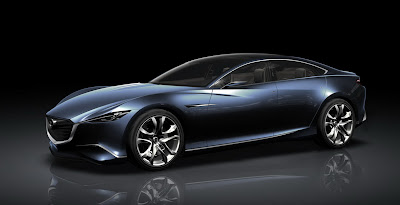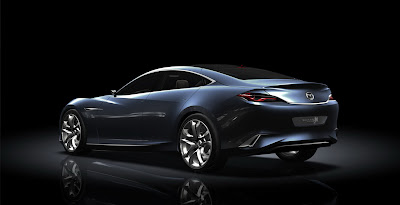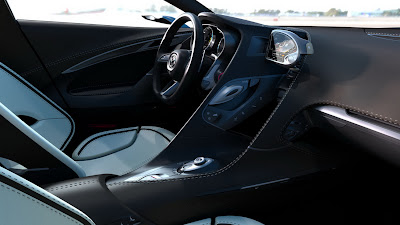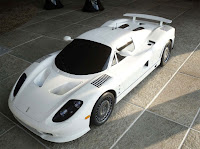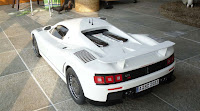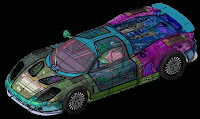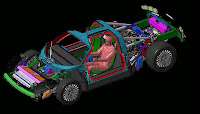- Smart new touch-screen infotainment system on all models
- Improved fuel economy and reduced CO2 emissions across the range
- 3.0L V6 and 6.0L V8 models capable of running on bio-ethanol
- Interior and exterior styling updates across all models
With the new range Holden has finessed the formula that has made Commodore the nation�s top selling car for 14 years straight, introducing smart multimedia technology, improved fuel economy and the capacity to run on environmentally friendly bio-ethanol.
VE Series II brings more multimedia features to the Commodore range than ever before through an all-new infotainment system that delivers full Bluetooth�, USB, iPod� and MP3 player integration across the range.
Known as Holden-iQ, the system is controlled through a clever, user-friendly touch screen mounted in the centre stack - the cornerstone of a refreshed interior across all models.
Introducing increased plug-and-play music functions and the ability to rip and store CDs on an internal flash drive[1], the system also delivers advanced satellite navigation features on selected models including live traffic condition alerts to help drivers avoid road congestion.
Commodore�s smart technology extends to the Series II powertrain line-up which delivers further fuel economy improvements on all models.
Holden�s frugal 3.0-litre SIDI V6 now achieves economy of 9.1 litres of fuel per 100 kilometres in the official ADR81/02 test. The 2 per cent improvement adds to the 12 per cent fuel economy gain made in September last year when Spark Ignition Direct Injection engine technology was introduced to the Commodore range.
The 3.6 litre SIDI V6 used to power premium Commodore models makes average fuel economy gains of more than 3 per cent while all luxury and performance models powered by Holden�s Gen IV V8 improve on average by more than 6 per cent.
The fuel economy improvements also result in reduced emissions across the range with all V6 models now achieving a four-star rating in the Federal Government�s Green Vehicle Guide.
In a major step towards creating a cleaner Australian fuel landscape, Series II introduces flex-fuel technology which enables customers to run their cars on bio-ethanol, known in many markets as E85; a blend of up to 85 per cent ethanol and 15 per cent petrol.
Bio-ethanol is a cleaner burning fuel made in Australia from the waste bi-product of wheat, sugar, sorghum and eventually even household garbage.
In Australia today use of the fuel reduces lifecycle CO2 emissions by up to 40 per cent when compared to petrol.
A first for an Australian-made car, Series II models powered by the 3.0 litre SIDI V6 and 6.0 litre V8 engines will feature this flex-fuel capability, allowing them to run on bio-ethanol, E10, Unleaded, Premium or any combination in between.
To support Holden�s release of flex-fuel vehicles, leading fuel retailer Caltex has introduced Bio E-Flex, a high-ethanol blended fuel to be sold in Sydney, Melbourne, Adelaide, Brisbane and Canberra from October.
Holden Chairman and Managing Director, Mike Devereux, said Series II, which also receives a range of exterior design enhancements, reflected Holden�s focus on continuous improvements for Commodore.
�Our approach to Commodore has been about making a great car even better,� Mr Devereux said.
�It�s about introducing more improvements more often and getting technology into the car that our customers need and want.
�That�s what we have done with VE Series II.
�Our customers have been telling us they want to see our models refreshed with greater functionality from Omega to Caprice.
�We have listened and responded in a way that continues to position Commodore as the smart choice for Australian motorists.�
Mr Devereux said the introduction of flex-fuel capability to Series II vehicles highlighted Holden�s commitment to making motoring better for the environment through leadership with alternative fuels.
�We have placed an enormous emphasis on developing technology that can be used in today�s vehicles to make driving better for the environment.
�That has included leading the way for Australian produced cars with bio-ethanol, providing motorists with a cleaner fuel alternative when filling up their car.
�It is the first major step forward in our efforts to move renewable fuels like bio-ethanol from a niche product into the mainstream, by making it available on Australia�s top-selling carline.�
Smart Technology � Holden-iQ
The Holden-iQ system brings music, telephone and satellite navigation features to Series II models in one clear, user-friendly arrangement.
The focus of the system is a fully integrated, 6.5-inch full colour multifunction LCD touch screen mounted in the centre stack of all vehicles across the Series II range.
Featuring rich colour graphics, the display has been benchmarked against high-end multimedia products such as computers, phones and video games, providing a wide range of audio-visual functions.
Music can be played via an iPod�, memory stick, CD or wirelessly transferred from a paired mobile phone. USB devices and iPods plug into dedicated sockets located inside the centre console, and all music file playback from compatible devices is controlled via the touch screen.
Holden-iQ also introduces �virtual changer� CD storage which replaces the mechanical stacker system from previous models with the capacity to rip and store up to 15 CDs on an internal flash drive. The system supports CDDA, CD-R, CD-RW, MP3 and WMA playback. DVD systems, where fitted, also display on the Holden-iQ touch screen.
New Bluetooth� functionality improves drivers� hands-free mobile phone experience. It synchronies a compatible phone�s address book and recent call history then displays the information on the touch screen. Outbound calls can be made via the contact list or a dedicated touch-screen key pad.
The high-feature Holden-iQ navigation system, standard on SS V-Series, Calais V-Series and Caprice models, delivers a high-clarity full colour mapping system, intuitive controls, live traffic alerts, speed advisory and point of interest functions. Voice guidance is integrated into the vehicle�s audio system.
It also features a touch screen keyboard to facilitate easy text entry, isometric and 3D map views and on-screen turn-by-turn and audio route guidance.
On those same models (except Ute) the touch screen also features a reversing camera display which is activated whenever reverse gear is selected. A strong safety feature, the colour screen display operates in tandem with audible park assist and works to show any obstacles directly behind the vehicle.
Improved Fuel Economy and reduced CO2 emissions
Holden engineers and designers working on Series II have instituted a series of modifications to produce an average fuel economy gain for all V6 models of 2.8 per cent and an average fuel economy gain for all V8 models of six per cent � making a combined average of just over four per cent across the VE and WM Series II range.
Modifications included aerodynamic improvements, which lower fuel consumption by reducing
the vehicle�s drag co-efficient, and mechanical changes. Omega and Berlina models were also fitted with lower rolling resistance tyres.
Aerodynamic improvements include:
- Addition of panels under the vehicle floor to reduce airflow drag (sedan and Sportwagon, excluding Omega)
- Reduced trim height on Omega and Berlina sedan
- Air deflectors fitted to the front of sedan rear wheels (Omega, Berlina Calais)
- Rear decklid re-design to include aero lip detailing (sedans)
- Front undertray modified to reduce drag
Mechanical changes include:
- Fitment of a clutched air conditioning compressor, which does not pump when the air conditioning system is turned off
- Engine idle speed reduction on 3.6L V6 SIDI variants
Further fuel saving enhancements see the Omega Ute brought into line with the remainder of the Commodore range, benefiting from Holden�s economical 3.0-litre SIDI V6 engine matched with the six-speed automatic transmission.
Styling
The multi-award-winning VE Commodore made a strong and dramatic design statement, characterised by its classic rear wheel drive proportions and an athletic stance emphasised by striking wheel arches.
For VE Series II, designers briefed to refresh the exterior have executed a series of subtle changes, including new front fascia, grille and headlamp treatments across the range.
Berlina specification and above feature new alloy wheels and the upper decklids of the sedan models are enhanced with integrated aero lip detailing.
On the interior, Holden has continued its trend of creating unique personalities for each model.
Mainstream, prestige and sports models all receive new centre stack features, mouldings, decoration and illumination colours.
Interior design work has focused on high standards of perceived quality, and creating a more �pilot oriented� cabin integrating new features and accessories.
Readily apparent is a higher-mounted, more prominent placement of the Holden-iQ system display screen, controls and air vents.
Interior and exterior design enhancements across the range include:
Omega
� Entirely new front fascia with a bolder, squarer appearance and new lower outboard inserts
� New larger grille, with a bright chrome detail surround and new hexagonal mesh inner
� Revised headlamp shape with new lens and bright bezel
� Decklid with integrated aero lip detailing
� New IP centre stack with 6.5-inch full colour touch screen
� New centre console surround
� New full width decorative appliqu�
� New HVAC controls
Berlina
Builds on Omega features with �
� New grille with prominent bright chrome crossbar
� New unique fog lamp surrounds
� New 17-inch, ten-spoke machine-faced alloy wheels
� New interior trim with woven fabric seat inserts and Sportec bolsters
Calais
Builds on Berlina features with �
� New front fascia and unique grille with prominent chrome header (attached to engine hood)
� New larger grille has full chrome surround, hexagonal mesh inner
� Lower fascia has full width bright detail
� Revised shape projector headlamps feature new black and bright bezel
� Full length bright chrome moulding on lower doors
� New 18-inch ten-spoke machined alloy wheels
Calais V-Series
Builds on Calais features with �
� New bigger 19-inch twin five spoke machined alloy wheels
Commodore SV6 and SS
� Exclusive sports front fascia, set apart by a new, larger grille
� Bolder, more muscular look accentuated by aggressive lower air intake
� Revised headlamp shape with new black bezel detail
� Integrated aero decklid lip detailing complements sports rear spoiler
� New 18-inch twin five-spoke machined alloy wheels
� New SS-style sports front seats for SV6 with deep bolsters and body-hugging contours
� High-mounted circular interior air vents.
� New sports centre stack with 6.5-inch full colour touch screen
� New sports IP decorative appliqu�
� New �white on Razor Grey� instrument cluster illumination for improved readability on SV6
� New �white on red� instrument cluster illumination for improved readability on SS
� Gloss black instrument cluster surround
� Razor grey finish �wrap-around� linear treatment on lower IP. Extends from IP into the door handle surround and through the console
Commodore SS V-Series
Builds on SV6 and SS features with �
� Revised shape projector headlamps feature new black and bright bezel (same as Calais)
� New twin five-spoke 19-inch machined alloy wheels
� Red finish �wrap-around� linear treatment on lower IP. Extends from the IP into door handle surround and through the console.
The VE Series II colour palette features 12 choices, including four new colours. The new colours are:
� Alto Grey � new mid-toned grey with silver highlights
� Hazard � head turning bright solid yellow
� Mirage Glow � a light, soft and luxurious beige
� Sizzle � bright metallic red
Carryover colors include:
� Heron � solid white
� Karma � an architectural blue with metallic highlights
� Nitrate � a classic silver metallic
� Phantom � metallic black with silver highlights
� Poison Ivy � a sports green metallic with blue highlights
� Red Hot � highly chromatic solid red
� Voodoo � solid electric sports blue
� Wildfire � metallic sports orange
More equipment, more features
Bluetooth� and iPod� integration is standard in all Series II vehicles, controlled through the Holden-iQ system.
Across the range each Series II model also receives dual-zone climate control and an outside temperature readout.











